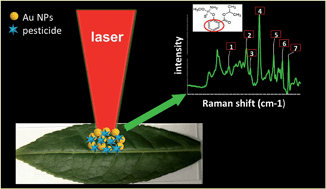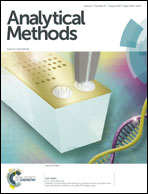In situ SERS detection of multi-class insecticides on plant surfaces†
Abstract
Organophosphates, pyrethroids and neonicotinoids are three major classes of insecticides applied in tea, fruit and vegetable cultivation. Chromatographic techniques coupled with mass spectroscopy are commonly used for the detection and identification of these insecticides. However, time consuming sample extraction and clean-up are always needed for these techniques. The objective of this study was to develop an in situ surface enhanced Raman spectroscopic (SERS) method that could rapidly and sensitively detect and discriminate these multi-class pesticides on plant surfaces directly without extracting them out. Four insecticides including isocarbophos and phorate (both are organophosphates), deltamethrin (a pyrethroid) and imidacloprid (a neonicotinoid) were used to contaminate the surfaces of fresh tea leaves and apples. Then 4 μL 250 μg mL−1 gold nanoparticle colloids (50 nm, citrate coated) were deposited on the plant surface contaminated with pesticides and then air-dried for Raman measurements. The results show that the four pesticides can be detected and discriminated in situ using the developed SERS method. The limits of detection (LODs) of isocarbophos, phorate, imidacloprid and deltamethrin were 0.25, 0.25, 0.5 and 0.5 mg kg−1 on fresh tea leaves, and 0.01, 0.01, 0.02, 0.02 mg kg−1 on apple peels, respectively. The developed SERS method provides a simple, rapid, and sensitive way to monitor these insecticides on plant surfaces for safe production of commercial tea, fruits and vegetables.

- This article is part of the themed collection: Detecting food authenticity and integrity

 Please wait while we load your content...
Please wait while we load your content...